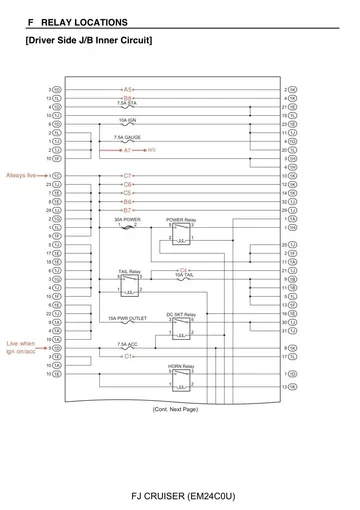TrickyT
Hate that mud...
On my FJ Cruiser I noticed a bunch of unused fuse positions in the interior DS fuse block. So when it came time to add a couple fused circuits for my refrigerator and seat heaters and I searched for threads on how to do this, I was surprised that apparently no one has ever directly used these pre-wired circuits before. Now Bussmann and Littelfuse both make "add-a-fuse" kits you can buy, but this approach blocks other existing fuse positions and thus prevents you from getting at those fuses or limits how many circuits you can add (see photo below).
I took a different approach. I used connector terminals, either ones you buy from Toyota (p/n 82998-12340) or the bare terminals you crimp onto wires yourself made by Sumitomo Electronics (see links below), and just added these to the empty positions in the terminal housing for the particular fuse position I wanted to use. It's a little more complicated than using an "add-a-fuse" kit because you have to access the needed connector and insert the terminals, but if you've ever worked with Toyota connector housings before you know this is pretty easy to do.
The key to this approach is knowing what connector positions go to which fuse positions. This information is not shown in the FJC electrical wiring diagram (EWD), but it's shown in the images I've included below. Also, you've got several options as there are pre-wired circuits that are always live, ones that are live only when the ignition is on, one that's live in the on or accessory key position, one that's live when the tail lights are on, and two that aren't connected to any power source but available for your needs.
All the details you need to know are shown in the images below or in the accompanying text.
Here's the fuse block I'm talking about showing all the unused positions:

Here's a picture from another thread showing how someone used add-a-fuse kits to add their circuits:

Here is the page from the EWD showing the fuse positions in column-row format and standard EWD connector designations. For example, the PWR OUTLET fuse is at location B5:

The back side of the fuse block has relays and more connectors:

[continued in next post]
I took a different approach. I used connector terminals, either ones you buy from Toyota (p/n 82998-12340) or the bare terminals you crimp onto wires yourself made by Sumitomo Electronics (see links below), and just added these to the empty positions in the terminal housing for the particular fuse position I wanted to use. It's a little more complicated than using an "add-a-fuse" kit because you have to access the needed connector and insert the terminals, but if you've ever worked with Toyota connector housings before you know this is pretty easy to do.
The key to this approach is knowing what connector positions go to which fuse positions. This information is not shown in the FJC electrical wiring diagram (EWD), but it's shown in the images I've included below. Also, you've got several options as there are pre-wired circuits that are always live, ones that are live only when the ignition is on, one that's live in the on or accessory key position, one that's live when the tail lights are on, and two that aren't connected to any power source but available for your needs.
All the details you need to know are shown in the images below or in the accompanying text.
Here's the fuse block I'm talking about showing all the unused positions:
Here's a picture from another thread showing how someone used add-a-fuse kits to add their circuits:
Here is the page from the EWD showing the fuse positions in column-row format and standard EWD connector designations. For example, the PWR OUTLET fuse is at location B5:

The back side of the fuse block has relays and more connectors:

[continued in next post]
Last edited:


